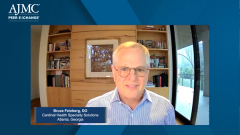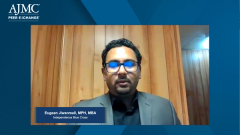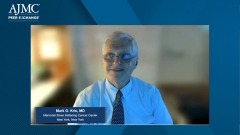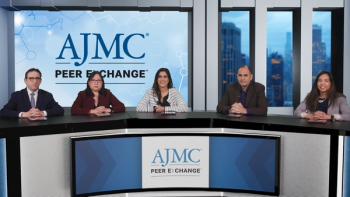
Molecular Testing Turnaround Times and Treatment Decisions
Variables that impact decisions to initiate therapy for solid tumor cancers versus wait for results of genomic profiling assays.
Episodes in this series

Bruce Feinberg, DO: Kenna, if you're not doing reflexive testing anymore, what would be the delay from the point the ordering physician in clinic with the patient decides and puts the order in, until they get a result?
Mark G. Kris, MD: Can I handle that one?
Bruce Feinberg, DO: I asked Kenna. You can't talk for her.
Kenna R. Mills Shaw, PhD: It should be the same period of time, though regardless, the order is done the same day.
Bruce Feinberg, DO: Both of you write it down on 3 by 5 card and then you can hold it up.
Kenna R. Mills Shaw, PhD: It's a 10- to 14-day period between the day of order and the day of test results if we have the tissue. If it's an external test, if the tissue's elsewhere, then it takes a little longer.
Bruce Feinberg, DO: But if the tissue is already available, it's 10 to 14 days, and if not, there's going to be a biopsy or some procedure, or it could even be lipid.
Kenna R. Mills Shaw, PhD: Or a request to get the sites covered.
Bruce Feinberg, DO: And Mark?
Mark G. Kris, MD: It's a little more complicated than that because you then need to follow the policies and procedures of the Pathology Department. So, material is accessed, material first goes through anatomic pathology, they get the pathologic diagnosis. They then order any immune histochemical testing they need to firm up the diagnosis - because yet for at least for most solid tumors, the molecular is not part of diagnosis that we'd use for some types. And then when all that is done the remaining tumor then goes to diagnostic molecular. And the tests can take various months. Is 2 weeks fair for NGS [next-generation sequencing], is that fair?
Kenna R. Mills Shaw, PhD: That's about right. We've ordered from MSK [Memorial Sloan Kettering], it's about 2 weeks.
Bruce Feinberg, DO: Now we have clinicians in the community, and some could be listening, but they're hearing what you're saying, they're having their own experience. And the question is, how long can they wait to initiate treatment on that patient for those results? And then what do they do in the interim?
Mark G. Kris, MD: This is the life of a thoracic medical oncologist. You meet the patient, you assess their illness, and you have to make a judgment call. Can you wait to get the results of the molecular testing based on their condition, based on the patients, their opinion about waiting or not? And this is the constant problem that we face now. We repeatedly have to see patients during this waiting time to ascertain whether it's safe to wait or do we just give a chemotherapy that could be administered regardless of the genomic profile.
Bruce Feinberg, DO: And I don't know. Is it 10% of patients who end up getting that chemotherapy because they really can't wait? Is it 20%? What do you think it is?
Mark G. Kris, MD: It's a smaller number now. You can't wait. It's probably I'd say 10% to 20%. That makes sense. It's a disruptive force here though that we haven't talked about yet and that's the blood test.
Bruce Feinberg, DO: I'm going to get there. I think I'm going to get there. I just want to follow through on the thought sequence. So, now you get a result back because you've ordered that comprehensive genomic profile of whatever type, we're going to use that today, we're not going to see NGS. And you're going to get that result and they are 2 weeks into treatment, 3 weeks into treatment. And the result identifies a highly likely mutation. That's a driver. What do you do?
Mark G. Kris, MD: Well, again, that's addressed in NCCN [National Comprehensive Cancer Network] guidelines. I think the standard of care today is in the absence of excessive toxicity. You follow that initial treatment through to the time where success or benefit can be determined. And when that assessment is made, there is a reevaluation of the patient, success of the first treatment, adverse effects and the likely benefit from the targeted therapy would exceed that. And then the decision is made whether to continue standard therapy or to move to the target therapy. There's actually NCCN guidelines that addresses that too.
Transcript edited for clarity.
Newsletter
Stay ahead of policy, cost, and value—subscribe to AJMC for expert insights at the intersection of clinical care and health economics.





























































